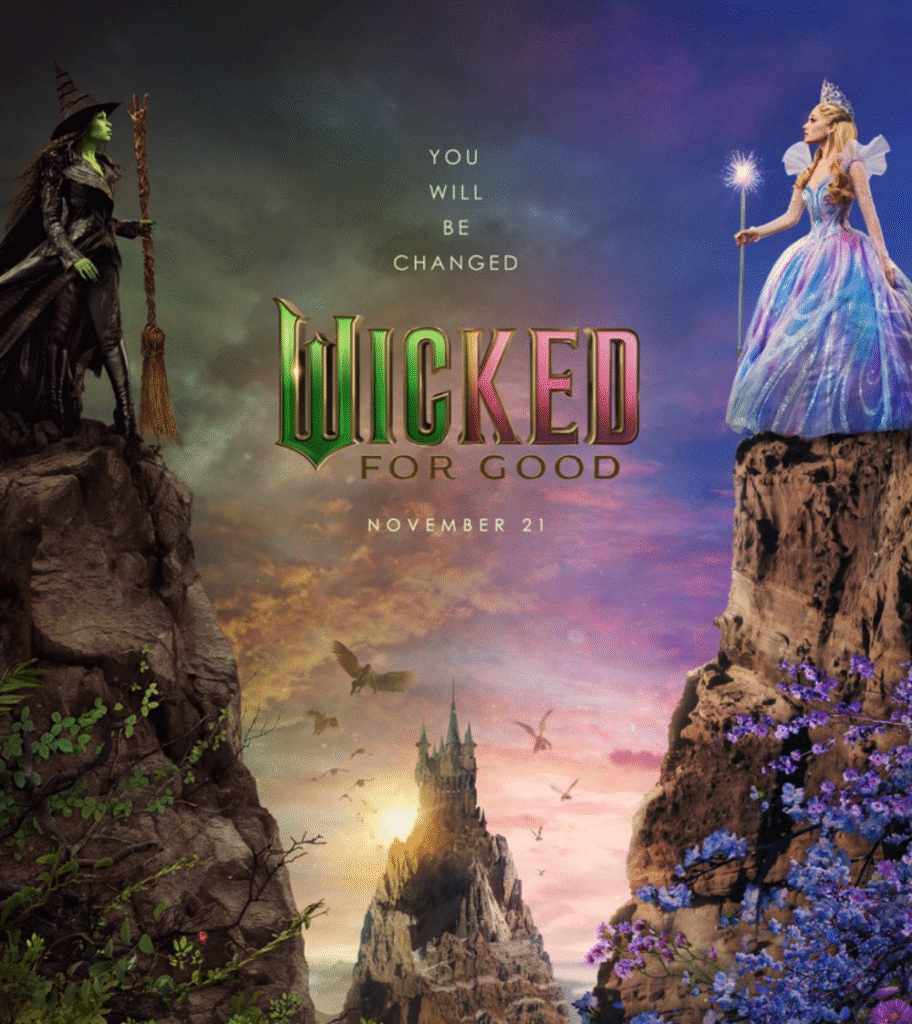Last week’s debut of the new musical movie, Wicked: For Good—also referred to as Wicked: Part Two—marks more than the long-awaited release of a highly-anticipated sequel. It represents the newest chapter in an American art form that’s been reinventing itself for well more than a century. As the Bruce Springsteen Archives & Center for American Music, musicals are certainly a part of our storytelling purview.

Wait—Who, or What, is Wicked?
If you’re not into musicals: Wicked: For Good is the title of the second Wicked film, named after the song “For Good.”
“For Good” is a powerful duet between Elphaba (the Wicked Witch) and Glinda (the Good Witch), where they acknowledge how deeply they’ve changed each other through their friendship — even though they may never see each other again. The phrase “for good” has a double meaning: it means “for the better” and “forever,” which gives their goodbye a bittersweet, lasting resonance.
The Wicked movies are based mainly on the Broadway musical Wicked.
That Broadway show (which opened in 2003) was adapted from a novel by Gregory Maguire called Wicked: The Life and Times of the Wicked Witch of the West (1995). Maguire’s book gives a more complex, sympathetic backstory to Elphaba (the Wicked Witch) from The Wizard of Oz (the classic 1900 novel by Frank Baum, turned into the beloved 1939 movie featuring Judy Garland as Dorothy).
Wicked has connected deeply with audiences because its story reframes a familiar tale with empathy, showing that outsiders, misfits, and misunderstood people can be heroes. The friendship between Elphaba and Glinda—complex, supportive, and transformative—has become especially meaningful for fans, who see their own relationships reflected in it. Its themes of identity, belonging, and challenging the status quo, paired with powerful songs like “Defying Gravity” and “For Good,” have made it a long-lasting emotional touchstone for multiple generations.
Now—Your History Lesson
I for many years had the pleasure of teaching a class here at Monmouth University called “History and Hollywood.” I can tell you it seems every decade since Hollywood has existed, there has been a Broadway musical so timely and beloved that it moves to film and captures something essential about its moment.
Oklahoma!, which premiered on Broadway in 1943 and on film in 1955, told a story of love, community, and changing frontiers in early 1900s territory life, capturing the optimism and tensions of a young America on the brink of statehood. Its initial Broadway release spoke directly to the anxieties and hopes of a nation in the midst of World War II, as its portrayal of a tight-knit community, everyday heroism, and a hopeful future resonated with audiences longing for stability, unity, and the promise of renewal.

Guys and Dolls, which opened in Broadway in 1950 and was released in movies theaters in 1955, blended witty comedy with a heartfelt exploration of luck, love, and second chances as a gambler courts a missionary. It tapped into postwar America’s appetite for escapism and optimism: its colorful depiction of New York’s underworld, romantic hijinks, and good-natured moral reform offered audiences a playful, stylish antidote to the recent austerity of wartime, celebrating a booming era defined by confidence, consumer culture, and big-city glamour.

Hair premiered off Broadway in 1967, moved to Broadway in 1968, and jumped to film in 1979. It follows a young man from Oklahoma who travels to New York before reporting for the draft and is swept up by a free-spirited group of hippies whose antiwar ideals and unconventional lifestyle challenge his worldview and change the course of his life. It captured the turbulence and transformation of the late 1960s: its celebration of free expression, psychedelic sound, anti-war activism, and challenges to traditional authority mirrored a generation questioning social norms, protesting the Vietnam War, and redefining culture, identity, and politics in real time.

A Chorus Line took Broadway by storm in 1975 and was adapted for film in 1985. The plot centers on a group of dancers auditioning for a Broadway show, each revealing their personal stories as they competed for a handful of coveted spots in the chorus. It explored identity and vulnerability in a raw, contemporary voice. It spoke powerfully to a post–Vietnam War and post–Watergate America by spotlighting ordinary people striving for dignity, honesty, and recognition.

Rent opened off Broadway before moving there in 1996. The movie came in 2005. Rent followed a group of young artists and friends in 1990s New York City as they navigated love, loss, and the challenges of living with HIV/AIDS while fighting to create meaningful lives against the odds. It resonated deeply with a generation grappling with alienation, gentrification, and economic uncertainty in urban America.

Of course, this list is not exhaustive (please don’t come for me, Hamilton fans.)
The Musical Persists into a New Century
Today, Americans are bombarded with content across multiple platforms—Broadway stages, movie theaters, streaming services, social media, and more. And yet, the lure of musicals, on stage and screen, persists, as it has for generations. This particular artform allows characters—and audiences—to sing what can’t be said, and to push beyond realism toward something aspirational, cathartic, or just plain fun.
As one of the defining musicals of the early twenty-first century crosses into a new era, Wicked already carries with it more than two decades of cultural resonance. Its renewal invites us to think about what comes next. The future of the American musical is likely to be even more hybrid, more global, more willing to blend genres and mediums. And if history tells us anything, the shows that last will be the ones that speak honestly to their moment—as Wicked and Wicked: For Good do.
Melissa Ziobro
Director of Curatorial Affairs
Bruce Springsteen Archives & Center for American Music
Monmouth University
November 24, 2025
